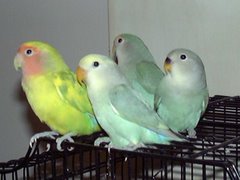Peach-Faced Lovebirds Breeding
 Peach-Faced Lovebirds are quite easy to breed when compared to other species. However, pairing the birds can be quite difficult since the two sexes are very similar. It is best not to try breeding lovebirds younger than a year.
Peach-Faced Lovebirds are quite easy to breed when compared to other species. However, pairing the birds can be quite difficult since the two sexes are very similar. It is best not to try breeding lovebirds younger than a year.Lovebirds can be called as "pitbull of birds" and for good reason. Generally the hen can show aggression towards on its mate with no warning. You can find one dead bird in the cage once you return from office. Hence getting a suitable pair is really difficult. If you're successful in finding a suitable pair, then you will be rewarded with few clutches of cute little baby lovebirds.
A nest box with a surface area of approximately 10 sq. inches (25 sq. cm) is sufficient. In contrast to most other parakeets, these birds do make nests, usually using coarse twigs that they gnaw into strips.
Between 3 and 5 eggs are laid which the female incubates for between approximately 18 and 20 days. Fledging occurs at least a month or one and a half months after hatching. The very young birds of this species are recognizable due to their partially black beaks. Peach-Faced Lovebirds may well produce a number of clutches per year.


No comments:
Post a Comment